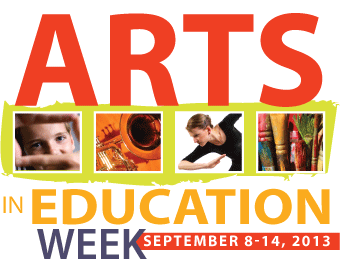The following guest post was written by Jennifer Olson, the “My Masterpieces” Program Director at the Pasadena Educational Foundation. The K-6 program worked to integrate arts and humanities with core academic subjects and increase students’ exposure to the arts.

At the beginning of this year, I found myself back at the ballet barre after a sixteen year hiatus. Part dare, part New Year’s resolution.
I felt a little ridiculous at first. Let’s be real: I’m almost 40, I have two young children and building my career as an arts education administrator has been all-consuming. Who do I think I am trying to dance again after so many years of not dancing, said inner critic. I spent the first few weeks apologizing for even being there. But the teacher said something that resonated with me. She thanked us at the end of each class for “remaining teachable.” As an educator that struck me as a powerful statement, and it made me think: isn’t that one of the benefits of arts education – that it creates lifelong learners? That it can help us all remain teachable?
My own education in the arts began in public schools. In elementary school, there were school plays; we had music and visual art class every week. In middle school, I remember rehearsing songs for Oliver! and playing scales on the French horn over and over. High School was when I found dance, photography and painting; our regional public high school had a photography lab, ceramics, silversmithing, drawing & painting, a thriving dance group, and even a theater class that taught clowning as an art form (it counted as P.E. credit!). Although arts education offerings are typically not this robust today – and not as well funded — as it was when I was a student, it hasn’t all fallen prey to the budget-cut-chopping-block. I see echoes of my own public school arts education when I see all of the programs happening in Pasadena Unified School District: the cadre of elementary music teachers who strive to reach every school, the elementary museum & art education program My Masterpieces, the abundance of middle and high school musical and theatrical performances that let students shine every spring, and the unsung art teaching that happens in classrooms every day, through middle and high school arts specialist teachers, generalists, and community artist partners alike, with few resources and many students to reach. The short films in GO PUBLIC like Roxanne DuBoucheron, Joel Lopez, Ana Rodriguez, and Alison Garfinkel are a testament to the fact that while the arts funding has diminished, the mantra that there “is no art in public school” is a fallacy.
There are many good reasons why we (still) have (some) arts education in our public schools, and why there should be more of it. Some students become professional artists, and that’s not as farfetched as it sounds: 1 in 8 regional (Los Angeles County) jobs is in the creative economy, and nationally, the nonprofit arts and culture industry alone accounts for 4.13 million full time jobs. For those who don’t become professional artists, the intellectual benefits of learning an art form have been well documented. Elliot Eisner’s Ten Lessons the Arts Teach sums it up nicely, but if you want details you can download a free copy of the Arts Education Partnership’s latest bulletin, which pulls together research that demonstrates how the arts teach the 4 C’s (Creativity, Critical Thinking, Collaboration, and Communication), boost academic achievement in language arts and math, and prepare students for life.
Beyond these excellent and practical rationales for arts education, arts education in public schools nurtures generations of lifelong learners in the arts. What I’m doing in my ballet class, along with all the other adult learners, is not fluffy. It’s hard work, mentally and physically. Just as the research in arts education shows, making art is thinking, practicing, sticking with it, and letting the practice make demands of you. You have to learn from your mistakes, or you don’t improve. In other words, you have to remain teachable. And in a world that is constantly changing, don’t we want adults who are still able to learn?
If you want to support arts education in Pasadena Unified right now, make a donation to the PEF Arts and Music Fund. Every donation, large and small, helps us provide musical instruments and art supplies to students.”



